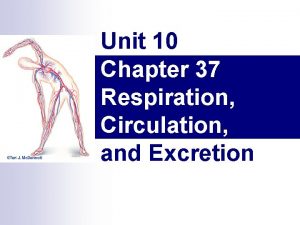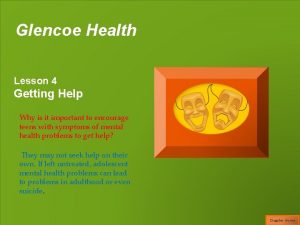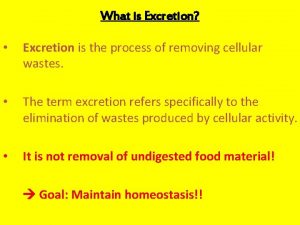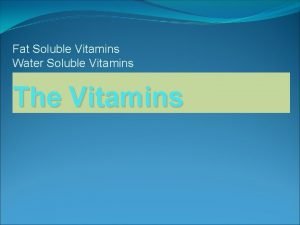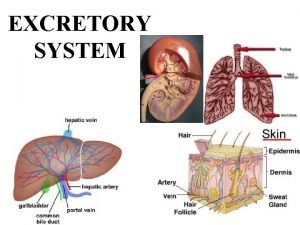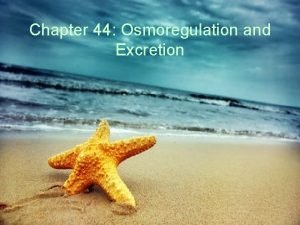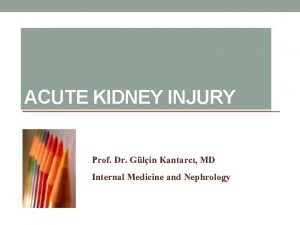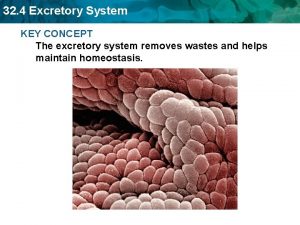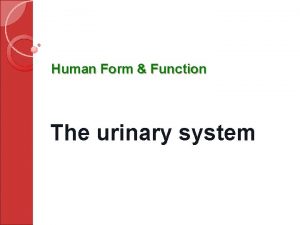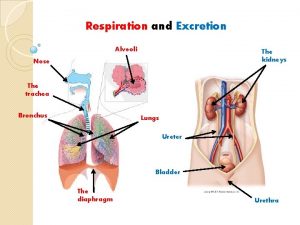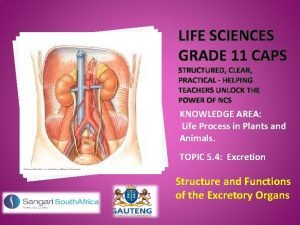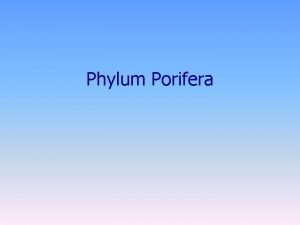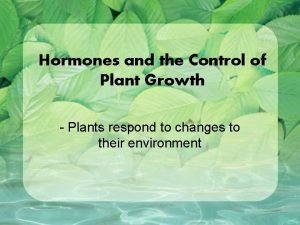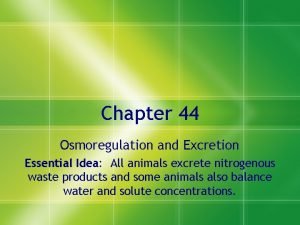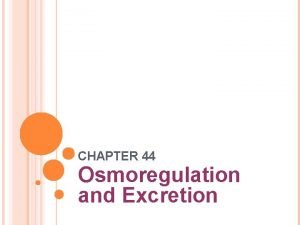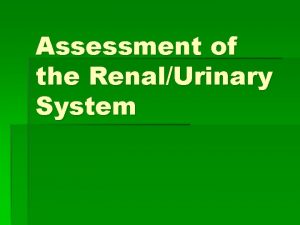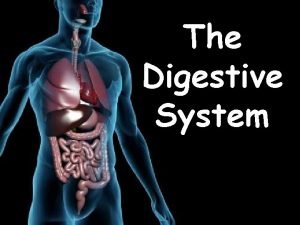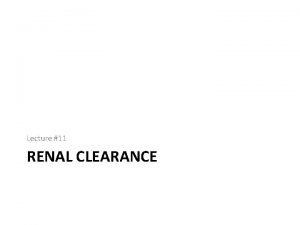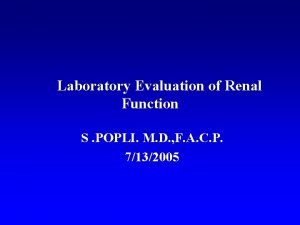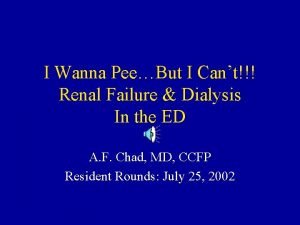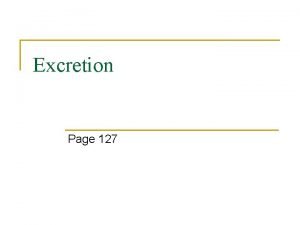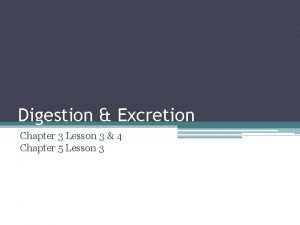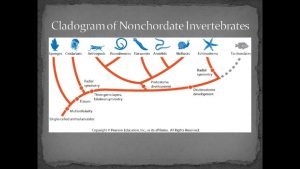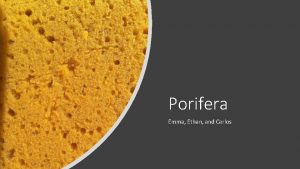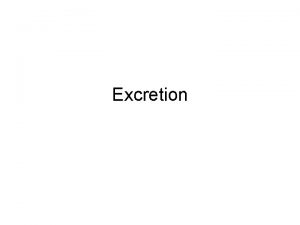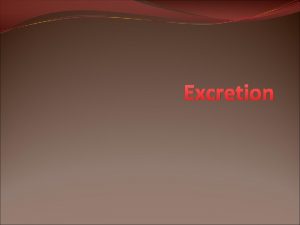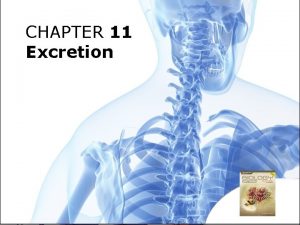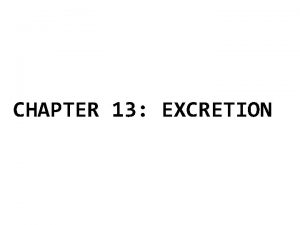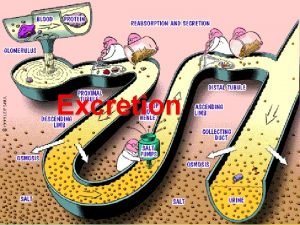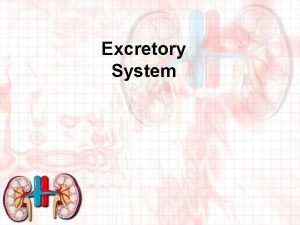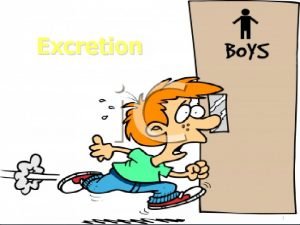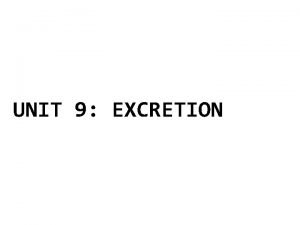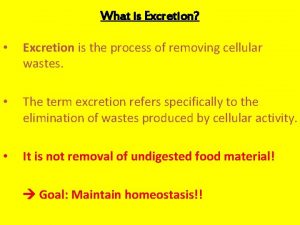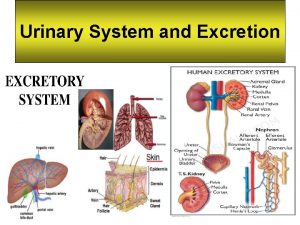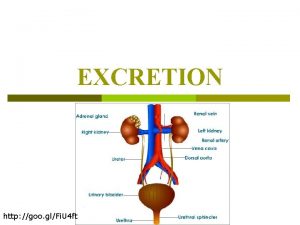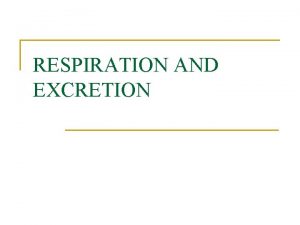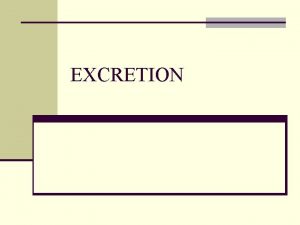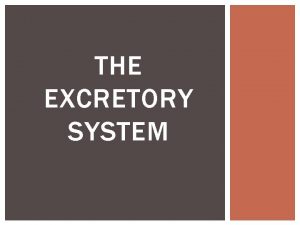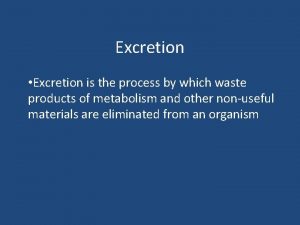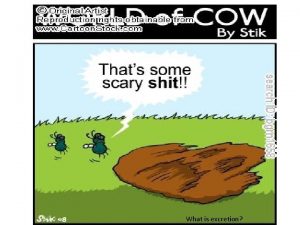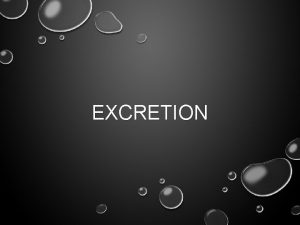Chapter 31 Excretion 1 Excretion is the getting




























































- Slides: 60

Chapter 31 Excretion 1

Excretion is the getting rid of waste products of metabolism. 6

EXCRETION IN PLANTS 7

1. Plants often recycle their waste products e. g. Oxygen and water vapour produced during the day in photosynthesis is used in the night during respiration. Carbon dioxide produced during the night in respiration is used during day in photosynthesis. 8

2. Plants shed their waste products. These are lost when the plant loses its leaves, bark, petals, seeds and fruit. Other plants store some wastes e. g. in xylem vessels. 9

3. Waste gases diffuse out through the stomata & lenticels. 10

LEARNING CHECK 1. Define excretion. 2. Why must organisms get rid of waste products of metabolism? 3. How do plants get rid of their waste products? 4. Plants can lose water from where? 11

Homeostasis is the ability of an organism to maintain a constant internal environment within the body. The excretory system plays a role in homeostasis: 1. by maintaining the composition of an organism's fluids, 2. by preventing the accumulation of poisonous wastes which might interfere with metabolism. 12

Temperature Regulation in animals • Temperature influences the rate of enzymecontrolled reactions that sustain life. • Mammals and birds are endotherms (warm blooded): their source of heat is internal [from their own metabolic heat]. • They can operate in low temperature environments, as they can keep the rate of enzyme activity high. 13

• Most animals are ectotherms (cold blooded), they lose or gain heat by moving into areas where temperature is suitable, e. g. fish, amphibians, reptiles. 14

The Skin functions in relating the body temperature. The Skin is composed of 2 layers: 1. Epidermis • Cornified layer: consists of dead cells, full of keratin (waterproof layer). • Granular layer: consists of living cells • Malpighian layer: consists of cells continuously dividing by mitosis and many pigment (melanin) cells, which protect the skin from UV 15 radiation.

2. Dermis • Located inside the epidermis • Consists of connective tissue which contain cells with a strengthening protein called collagen. • Consists of blood vessels, sweat glands, hairs, sebaceous glands (sebum), and nerve receptors. The Subcutaneous layer contains fat in adipose tissue. 16

The SKIN 17

Functions of The Skin 1. Protection: • epidermis protects against damage, water loss, and the entry of pathogens • melanin protects against UV radiation • sebum (oil) keeps the epidermis intact 2. Vitamin production (vitamin D is made in the skin) 3. Food store (fat stores energy) 4. Sense organ (the skin is an organ of touch, e. g. it senses touch and temperature) 5. Excretion (sweat removes water and salts from the body) 18

Temperature regulation Cold conditions cause: – hairs to stand up to keep skin warm – blood vessels narrow (constrict) to retain heat – shivering Warm conditions cause: – sweating, which cools the body due to evaporation – blood vessels to widen (dilate) to lose heat 19

• The Human Skin Animation Video • What is skin? The layers of human skin 20

LEARNING CHECK • • What is an endotherm? What is an ectotherm? List the functions of the skin. What is our normal body temperature? What happens whern we get too hot ? What happens when we get too cold? What part of the brain detects changes in our temperature? 21

Organs of Excretion 1. lungs (water and carbon dioxide) 2. skin (water and salts) 3. kidneys (water, salts, and urea) 22

OUR EXCRETORY SYSTEM

Water is lost from the body through a number of ways: 1. Lungs –exhaled out 2. Skin – by evaporation from cells and through sweat. 3. Intestines – in the faeces (undigested food). 4. Kidneys – in dissolving the poisons and wastes we wish to excrete from the body. 24

LEARNING CHECK 1. What is excretion? 2. What role does excretion play in homeostasis in the body? 3. Name the main waste products of the body. 4. Name the main excretory organs of the body. 25

Excretion in human - Kidneys

The Urinary System consists of two kidneys, two ureters, the bladder, and urethra 27

A section through the kidney shows an • outer darker region (cortex) and • a lighter inner zone (medulla). Pelvis Cortex Medulla Ureter 28

The kidneys make urine in the following way: 1. blood (containing waste) enters the kidneys through the renal arteries 2. the kidneys filter waste and useful materials from the blood 3. useful materials are reabsorbed from the kidneys back into the blood 4. some materials are secreted from the blood into the kidneys 5. urine formed in the kidneys flows to the bladder through the ureters 6. blood (low in waste) leaves the kidneys in the 30 renal veins.

Filtration Pelvis Cortex Reabsorption Medulla Ureter 31

• Urinary system - The nephron 32

• Filtration: The kidneys filter waste e. g. urea and excess salts and useful materials e. g. glucose, amino acids, water from the blood into the kidney(cortex) • Reabsorption: the useful materials are reabsorbed from the kidneys back into the blood(cortex & medulla) • Secretion: some materials e. g. potassium, hydrogen ions are secreted from the blood into the cortex of the kidneys. 33

Urine • Urine is composed of about 96% water, urea, salt, and traces of other substances such as hormones. • In the liver, excess amino acids are broken down into urea. • Urea and other wastes, along with some water, are not reabsorbed. • They pass, as urine, into the pelvis of the kidney and to the bladder for storage. 34

Functions of the Kidney 1. Excretion of water, salts, and urea 2. Osmoregulation - control the water content of the blood (and body fluids) - control the salt concentration of the blood (and body fluids) 3. p. H control (by controlling the hydrogen ions) 35

The Nephron • The nephron is the functional unit (make urine) of the kidney • Each kidney contains more than 1 million nephrons • The nephron is a tube about 3 cm long • It is located in the cortex and the medulla of the kidney 36

KIDNEY LS 37

Blood supply to the Nephron • Blood enters the Kidney through the renal artery. • The renal artery divides into renal arterioles and then into smaller afferent (incoming) arterioles. • Each afferent arteriole divides into a cluster of capillaries (glomerulus). • Blood leaves the glomerulus in the efferent (outgoing) arteriole. • This divides to form capillaries which re –join to form renal venules & then renal veins. 38

39

NEPHRON 40

1. FILTRATION - takes place in the glomerulus • blood enters the nephron in the afferent arteriole, under high pressure, • A cup-shaped structure (Bowman’s capsule) surrounds each glomerulus, • and it is here that smaller waste and useful molecules in the blood are forced, under pressure, out of the plasma and into the lumen of Bowman’s capsule, forming the glomerular filtrate. 41

The Glomerulus and Filtration The glomerulus helps filtration in three ways: 1. The blood pressure is high - because the efferent arteriole is narrower than the afferent arteriole, so force-filtering the plasma. 2. Large surface area of the capillaries 3. Large number of pores in the capillaries 42

Everything except larger molecules enter the glomerular filtrate e. g. red & white blood cells, platelets, large proteins & some hormones. 43

2. Reabsorption The body cannot afford to lose useful chemicals like food and water, so as the glomerular filtrate passes from the Bowman's capsule into the proximal convoluted tubule, glucose, amino acids, some salts and water are reabsorbed back into the blood. The food molecules, including most of the salt ions, are taken back by active transport. 44

Animations - kidney 45

Proximal convoluted tubule Water is absorbed by osmosis from the Loop of Henle and convoluted tubules. Glucose, vitamins and other substances are absorbed by a combination of active transport and diffusion Salts are reabsorbed by active transport Urea and other wastes, along with some water, are not reabsorbed, but pass as urine to the bladder. 46

1. 2. 3. 4. Proximal convoluted tubule Is long(14 mm) Is thin walled, one cell thick Has lots of infoldings - microvilli Has lots of mitochondria – provide energy 47

The Loop of Henle The proximal convoluted tubule leads into the descending limb of the loop of Henle, which dips down into the medulla, turns (the loop), and returns as the thick ascending limb of the loop of Henle. 1. Water is reabsorbed by osmosis & minerals in the descending limb. 2. Salts are absorbed by active transport in the ascending limb. 48

Distal Convoluted Tubule Is involved in the control of water, salt & p. H values of the blood. • Some water & salts are reabsorbed into the blood. • Secretion of some substances e. g. hydrogen ions - when the blood becomes too acidic, hydrogen ions are secreted into the urine. 49

The Collecting duct Some water is reabsorbed into the blood. Any remaining glomerular filtrate that has not been reabsorbed back into the blood is collected in the collecting duct. This filtrate is now known as urine. It flows into the bladder through the ureters. 50

• Excretory System Song Learn about the structures of the excretory system and the formation of urine. 51

• Urine Formation 52

53

ADH – Anti-diuretic hormone 1. It controls the volume of urine formed 2. It is produced by the pituitary gland in the brain 3. It influences the permeability of the convoluted tubules 4. Controls osmoregulation, regulates the amount of water in the body by varying the amount of urine produced, an example of homeostasis. 54

55

LEARNING CHECK 1. 2. 3. 4. 5. 6. 7. Name the parts of the nephron Where does filtration takes place? What does not get filtered Where does reabsorption take place? What substances are reabsorbed? What are not reabsorbed? List some substances present in urine. 56

If you drink a great deal of water • the hypothalamus in the brain detects the diluted blood and turns off ADH production. • Less water is reabsorbed, so more water is allowed to escape to the bladder, • and a larger volume of dilute urine is produced. When the body is low on water • ADH is secreted from the pituitary gland. • More water is reabsorbed • and only a small volume of urine is produced. 57

Controlling water content 58

59

Thirsty or Salty Diet or Hot Day or Exercise Low water content High salt content ADH produced Distal tubule more permeable to water Collecting Duct more permeable to water Low volume of concentrated urine produced 60

Excessive water intake or a low salt diet High water concentration Low salt concentration ADH not produced Distal tubule less permeable to water Collecting duct less permeable to water High volume of dilute urine produced 61

High protein diet Normal water content High urea content Urine produced will have high urea content 62

LEARNING CHECK • What is ADH? • Where is it made and where does it act? • Explain what happens in a nephron where we take in a lot of fluid. • Explain what happens in each nephron when we have not taken in fluid for many hours.

• Urinary System Song 64

• Excretion Song with Lyrics 65
 The secret of getting ahead is getting started
The secret of getting ahead is getting started Chapter 37 respiration circulation and excretion
Chapter 37 respiration circulation and excretion Chapter 5 mental and emotional problems lesson 4 answer key
Chapter 5 mental and emotional problems lesson 4 answer key Chapter 5 mental and emotional problems
Chapter 5 mental and emotional problems What is excretion
What is excretion Factors affecting excretion of drugs ppt
Factors affecting excretion of drugs ppt Difference between water soluble and fat soluble vitamins
Difference between water soluble and fat soluble vitamins What is excretion
What is excretion What is excretion
What is excretion Types of excretion
Types of excretion Fractional excretion of sodium
Fractional excretion of sodium Excretory system
Excretory system Nicotine excretion
Nicotine excretion What is the function of glomerulus class 10
What is the function of glomerulus class 10 What is excretion
What is excretion Vitamin d for body
Vitamin d for body Respiration and excretion
Respiration and excretion Life science grade 11 kidney practical
Life science grade 11 kidney practical Seeds travel
Seeds travel Porifera excretion
Porifera excretion Insect excretion
Insect excretion Excretion
Excretion Hagfish excretory system
Hagfish excretory system Excretion
Excretion Excretion
Excretion Excretion
Excretion What is egestion
What is egestion Summary of drug administration
Summary of drug administration Pedicel
Pedicel Bun/creatinine ratio low
Bun/creatinine ratio low Diasylate
Diasylate Qqbreak
Qqbreak Metabolic waste
Metabolic waste Digestion and excretion lesson 3
Digestion and excretion lesson 3 Enchinoderma
Enchinoderma Porifera excretion
Porifera excretion Hát kết hợp bộ gõ cơ thể
Hát kết hợp bộ gõ cơ thể Slidetodoc
Slidetodoc Bổ thể
Bổ thể Tỉ lệ cơ thể trẻ em
Tỉ lệ cơ thể trẻ em Chó sói
Chó sói Tư thế worm breton là gì
Tư thế worm breton là gì Alleluia hat len nguoi oi
Alleluia hat len nguoi oi Các môn thể thao bắt đầu bằng tiếng nhảy
Các môn thể thao bắt đầu bằng tiếng nhảy Thế nào là hệ số cao nhất
Thế nào là hệ số cao nhất Các châu lục và đại dương trên thế giới
Các châu lục và đại dương trên thế giới Cong thức tính động năng
Cong thức tính động năng Trời xanh đây là của chúng ta thể thơ
Trời xanh đây là của chúng ta thể thơ Cách giải mật thư tọa độ
Cách giải mật thư tọa độ 101012 bằng
101012 bằng Phản ứng thế ankan
Phản ứng thế ankan Các châu lục và đại dương trên thế giới
Các châu lục và đại dương trên thế giới Thơ thất ngôn tứ tuyệt đường luật
Thơ thất ngôn tứ tuyệt đường luật Quá trình desamine hóa có thể tạo ra
Quá trình desamine hóa có thể tạo ra Một số thể thơ truyền thống
Một số thể thơ truyền thống Bàn tay mà dây bẩn
Bàn tay mà dây bẩn Vẽ hình chiếu vuông góc của vật thể sau
Vẽ hình chiếu vuông góc của vật thể sau Biện pháp chống mỏi cơ
Biện pháp chống mỏi cơ đặc điểm cơ thể của người tối cổ
đặc điểm cơ thể của người tối cổ Giọng cùng tên là
Giọng cùng tên là Vẽ hình chiếu đứng bằng cạnh của vật thể
Vẽ hình chiếu đứng bằng cạnh của vật thể

